‘Who Knew?’ is sponsored by Walter Stewart’s Market.
When facing the waning years of your (ahem) forties, you have two choices. You can learn all the Gen Z slang and TikTok dances to cling, Gollum-like, to your waning youth, or you can slide into the sensible, low-heeled comforts of the retiree lifestyle a couple of decades early and start caring about things like warblers, relaxed-fit pants, and the lighthouses of the Eastern Seaboard. Twenty-two-year-old you might not recognize 47-year-old you, and there’s no doubt she’d judge your dorky fleece vest and Investment Binoculars™, but there’s much to be said for shifting yourself into a less chaotic gear and finding moments of actual presence in the natural world. Life begins to look more like a Mary Oliver poem than a Bret Easton Ellis novel, and that’s a-ok with me.
This means making certain choices with confidence: a Yankee Magazine webinar about fall foliage on a Tuesday night? Yes! A pair of reading glasses in every room in my house? But how else will I read my many LL Bean catalogs?! And an educational stroll with Connecticut’s foremost birding expert through the third-oldest bird sanctuary in the country? Absolutely.
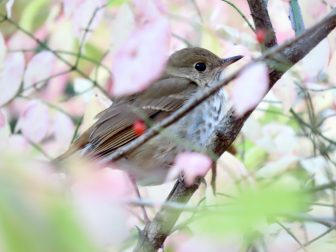
A wood thrush enjoying Bristow in the spring. | photo: Chris Schipper
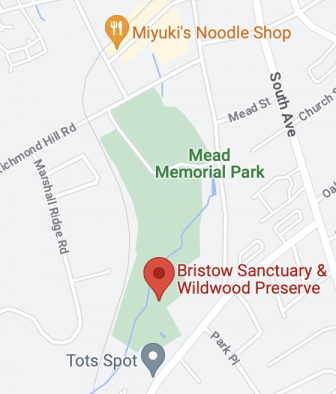
Bristow Bird Sanctuary is conveniently close to Miyuki’s Noodle Shop, just sayin.
“I used to go clubbing in Ibiza,” Robin Bates-Mason recently observed. “Now I go birding.” She’s onto something; watching birds is an active way to spend time in nature and an intentional moment of community with the creatures who share our space. It also forces you to quiet your personal chaos and just listen. New Canaan’s Helen and Alice Bristow Bird Sanctuary and Wildwood Preserve, a gemlike 17-acre parcel tucked between Mead Park’s baseball diamonds and Old Stamford Road, is the best possible place to get your feet wet in the birding universe (although they won’t, clad as they are in those sturdy, hideous, Gore-Tex walking shoes.)
Let’s look at how Bristow came to be and what makes it such a special place.
There is sound economic reason for protecting the birds; and in addition, there is ample reason for protecting them simply because they add immeasurably to the joy of life.”
— Theodore Roosevelt, in his introduction to Wild Bird Guests: How to Entertain Them by early New England bird conservationist Ernest Harold Baynes
At the turn of the 20th century, our built environment hadn’t yet overtaken so much of the natural world, but people were beginning to realize that it easily could. The National Parks System was established in 1872 to preserve some of the West’s most geologically remarkable spaces for everyone’s enjoyment. On the other hand, much of the East Coast had already been built up and was (presumably) taken for granted. Passenger Pigeons, then one of the most plentiful birds in North America, were thought to be inexhaustible until hunted to actual extinction. Martha, the world’s last living specimen, took her last breath at the Cincinnati Zoo in 1914.
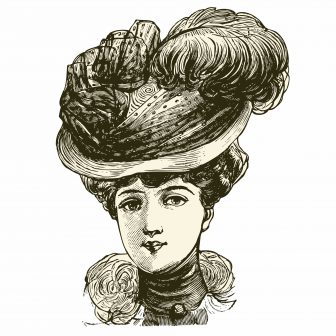
Murder but make it fashion | source: Adobe Stock
Inspiration to protect birds came from above, though not how you might think. Initial ire was directed against (drumroll, please) women’s hats? The millinery of the day was absolutely lousy with feathers, and in the late 1800s, women in Boston began organizing teas to plead with their friends to stop wearing entire egrets atop their heads already. Fashion is a powerful force, but nothing outcompels a roomful of judgy women. Passionate locals established two other bird sanctuaries–in Meriden, New Hampshire, and good ol’ Fairfield, Connecticut. By the time the movement reached New Canaan, the Migratory Bird Protective Act had been ratified in 1918. A resolute group of dedicated stewards banded together to form the New Canaan Bird Protective Society, devoting their time and resources to protecting local wildlife at large.

A first-growth sugar maple stands tall over Bristow
Let’s talk about dedicated stewards: spend enough time in New Canaan, and you’ll realize that we have generations of these individuals to thank for our sense of place. Everything from land conservation to historic preservation has a crew of volunteers doing the fundraising, handshaking, and activism necessary to keep what’s most important in our town safe from the predations of developers, mini-malls, and bad decisions. Chris Schipper currently bears the torch for nature conservation in New Canaan, serving as chairman of the New Canaan Conservation Commission and leading the Friends of Bristow group. “I was drawn to New Canaan because I liked the look of it,” Schipper says. “It’s not that I want to keep it from ever changing, but I want to help people appreciate what we’ve got.”
Schipper’s predecessors in conservation leadership read like a Who’s Who of early New Canaan; you might recognize your ancestors (or at least your street name) among their ranks. Harry Bates Thayer had been the president of AT&T and the highest-paid executive in America, and after retirement, his second act was dedicated to building up the Bird Protective Society. Thayer served as its first president. Nurseryman and florist Stephen B. Hoyt succeeded him and made finding land for a sanctuary his mission. This was achieved with Mrs. Barend Van Gerbig, (that name!), who doled out the necessary capital to buy 17 acres of swampland and gravel pits that became the New Canaan Bird Sanctuary.

Running water, to put it into early aughts terms, is your milkshake that brings all the boys to the yard | photo: Andrew Ault
Says Schipper of the parcel, “It’s got lowlands. It’s got wetlands. It’s got running water, which is really important. When they decided to make it a bird sanctuary, they did their homework and said, ‘This has enough terrain and trees and brush and water, and it’s on the migratory path.’” In 1987, the sanctuary was renamed for Helen and Alice Bristow, two sisters who had served the society at length. Helen Bristow even wrote a birding column in The New Canaan Advertiser called ‘Round Robin.’ A woman after my own heart!
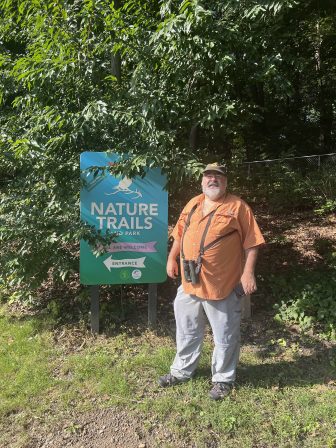
Mr. Gallo’s calls are so convincing, my phone classified him as a barred owl.
Right now, we’re in the peak migration season (let’s think of it as Avian Fashion Week), and the Bristow Sanctuary is teeming with species on their way somewhere warmer and those who hang out here year-round. The Friends of Bristow organized a birding walk with Frank Gallo, the leading authority on birding in Connecticut, and we showed up for what is exceptionally shameful to admit now, my first Bristow visit. For the nine years we’ve lived here, I’ve never been because, one, I wasn’t sure where the entrance was, and two, I assumed that, since it’s a sanctuary, I couldn’t bring our dogs. No more excuses: the gate is found by walking past three Mead Park ballfields at the tree line to the west, and a muddy, trundling golden retriever informed me that dogs are, indeed, welcome.
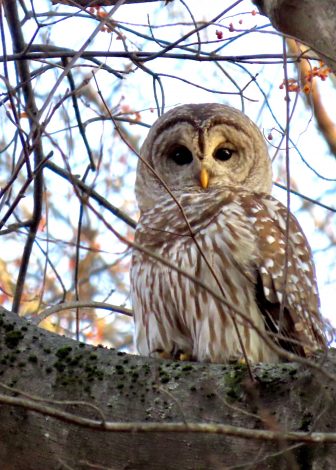
An actual barred owl | Photo: Chris Schipper
It was initially tough to hear anything over the absurd decibel level of gas-powered leaf blowers, but Frank directed us to look for movement in the canopy first. He then made a series of calls mimicking species scolding each other (nobody’s immune to the spectacle of drama, be they avians or bystanders in the comment section), and out they popped: Warblers, Wrens, Red-bellied Woodpeckers, Tufted Titmice, and a little green Hummingbird.
In the 1924-25 inaugural season at New Canaan Bird Sanctuary, observers clocked 91 unique species of birds. Today, that number has reached 114, an exciting uptick in a generally downward-trending category. By all accounts, bird species are diminishing mightily due to habitat loss and climate change, and we’ve lost something like 3 billion individuals since 1970 in North America. It might be that our tools for observation are getting better; I really like Cornell University’s AI-powered bird classifying app that uses audio recordings to tell you what you’re hearing in the trees above, though real birders like Mr. Gallo are still a bit skeptical of the tech and prefer to ID birds by sight. Either way, bird diversity is an accurate indicator of ecosystem health, and this positive delta of 23 species means that New Canaan has done something right all these years. This is thanks in no small part to our grand tradition of dedicated stewardship, owing to the character of people like Chris Schipper, Frank Gallo, and former nightclub enthusiast Robin Bates-Mason, who co-founded Planet New Canaan.
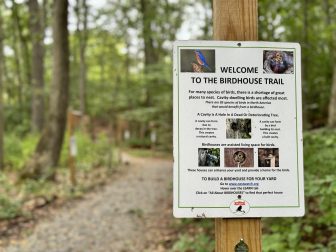
Next project: build birdhouses! | photo: Andrew Ault
The truth is, we can all be better friends to our feathered friends. Here are some simple steps we can all take to look out for the birds and to help Bristow. If I sound a bit scoldy, just remember, I’m cosplaying as a birding enthusiast retiree, and you need to heed your elders.
- Donate to the New Canaan Community Foundation (NCCF) and earmark your donation for Bristow Park (this can be done online by clicking “Give Now” here, by calling 203-966-0231, or by emailing info@newcanaancf.org).
-
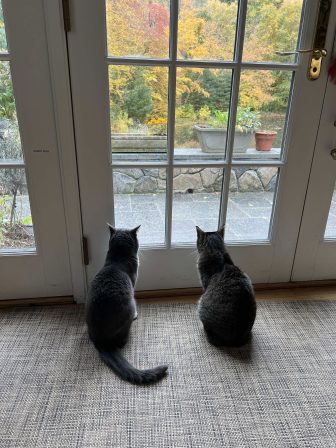
Polly and Bobby Ault, wishing they could go outside and act upon their murderous little thoughts
Keep your avicidal little monsters (you may know them as cats) inside, or have them wear a bell collar if they must roam. Indoor cats have longer lifespans by a factor of 4 (!) and the creatures Kitty would likely ruthlessly murder for sport surely prefer it
- Calm down with the leafblowers and overlit landscapes! Birds rely on their hearing to eat, communicate, mate, and migrate. They often navigate at night and use the stars to establish migratory patterns. Buy a rake or an electric leafblower, and ease the throttle on your landscape lighting during peak migratory seasons (mid-Spring, early Autumn)
- Consider the bottom of the food chain. Birds eat invertebrates, and larger species eat small rodents. Pesticides are indiscriminate, so when you spray your yard for mosquitos, no matter what, you’re depriving somebody of dinner. When you set poison traps for mice, chipmunks, and voles, you’re probably poisoning owls and hawks as well
- Stock your birdfeeders well, particularly during migration season!
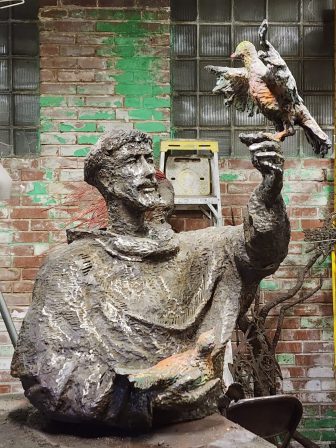
Brother sun: the steel statue of Francis of Assisi that will soon be installed
The Friends of Bristow’s five-phased plan for restoring the park in time for its centennial is nearing completion. One final piece of the puzzle: a statue of St. Francis of Assisi, the patron saint of ecology and animals, will overlook the park with his customary benevolence and goodwill. Francis of Assisi’s story is fascinating; he really lived it up in the twelfth century as a young man, but was convinced by a vision to abandon his worldly pursuits and live a life of poverty and service to his beliefs. His midlife reckoning was more drastic and more consequential than mine; nobody’s going to put a statue of me in their garden because I’ve decided to wear uglier shoes. St. Francis came to consider the natural environment as God’s mirror, and he knew the elements as Brother Sun, Sister Moon, Brother Wind, and Sister Water. He served his beliefs with humility.
May Bristow inspire us all to follow suit.
The next Bristow birding walk with Frank Gallo is planned for October 20th at 8:30 AM. These events a free of charge, require no registration, and are a (literal and figurative) hoot. I encourage you all to attend!
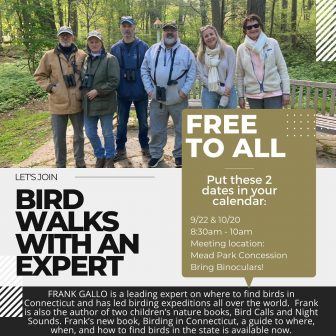
HANDY RESOURCES:
- An excellent deeper-dive history of the Bristow Sanctuary
- Frank Gallo’s Birding in Connecticut at Elm Street Books
- The Sibley Field Guide to Birds of Eastern North America at Elm Street Books
- Some retiree-chic practical footwear to take you from the trails to that 5 PM dinner
BIG THANKS TO:
Mike Dinan, Chris Schipper, Frank Gallo, Robin Bates-Mason, my friend Walt Smith, and comedian Gabriel Rutledge connecting all the dots and providing inspiration and direction for this month’s column.
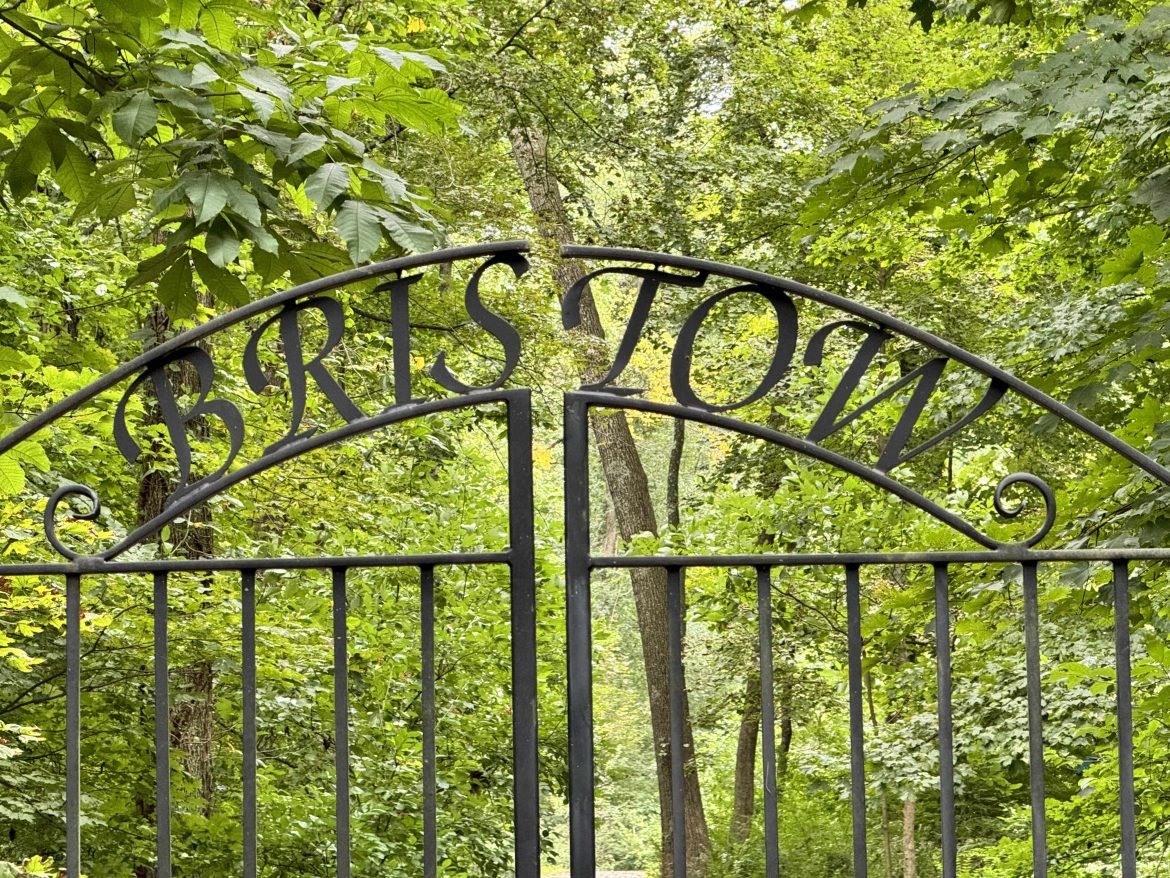
Great piece Laura! Turns out the comedian’s name is Gabriel Rutledge. -Walt
As a fellow bird nerd, thank you for this funny and informative article! For those who want to geek out even more about our feathered friends, check out the CT Ornithological Association. They post lots of informative tips, including recent sightings of an errant Roseate Spoonbill who has accidentally blown out of its typical southern range on the winds of a hurricane and has been hanging out in Stratford.
An awesome article, Laura! I love your humor but, equally important, your in-depth research about this important local site. Chris is a force of nature as were the folks before him. New Canaan is very fortunate to have all those who work to preserve and care for open space!
Bristow Sanctuary is a gem! Did you know that the New Canaan Bird Club now part of National Audubon, had its “head quarters” in the Bristow Sanctuary . Meetings were held in a shack (torn down many years ago) in the Sanctuary because Bristow had become a favorite birding location: small and pristine. Over the years it became rundown with paths overgrown and a pond that was becoming more of a mud hole. Today, after much planning and hard work , thanks to a dedicated group of people, it has become a favorite birding spot once again. Thank you all for restoring this little gem!
As always, Laura delivers to us informative and fun information about New Canaan for us all to enjoy. Thank you!
What an amazing article. I am so intimidated by your prose, that I hesitate to write a comment as I sorely lack your literary skills! Couldn’t agree more that Chris and former clubber Robin are both forces of nature. Signing up for the next walk now, and putting out the bird feeders, dimming the lights – and thanks to Robin we are already off any pesticides.
Good website I would love to take the walk.I just love birds!
Thanks for this lovely article about birds Laura! I particularly appreciate the history of caring for birds.
We must do all we can to protect our feathered friends.
Finally a topic on which we can all agree; who doesn’t want more and varied bird life in Connecticut. I’ve loved songbirds especially the melodic song of the wood thrush in spring and summer. Excellent article.